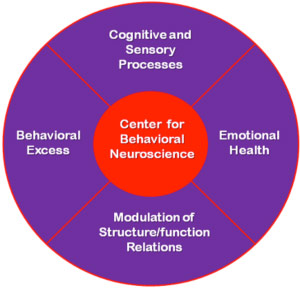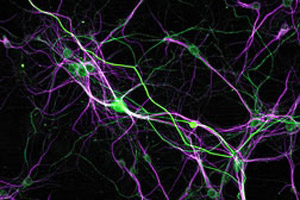Contact Us
Contact:
Rachel Crupi
Coordinator
Research at the Center for Neuroscience and Behavior

The members of the Center for Neuroscience and Behavior strive to achieve the highest standards for research on the processes and substrates that underlie normal behavior as well as the pathologies that lead to behavioral dysfunction. There is little doubt about the importance of this work. Disorders of the brain and behavior, including obesity, depression, addiction, and cognitive dementia, are currently among the most costly, pernicious, and widespread threats to human health and quality of life. To address these and other important problems, the members of the Center for Neuroscience and Behavior have joined together to form a hub of research excellence that encompasses four broad and interrelated research themes. Consistent with a multi-disciplinary perspective, many of the Center's members have research programs that span more than one of these areas.
Behavioral Excess
The term "behavioral excess" refers to (a) otherwise normal behaviors that become maladaptive due to the high frequency or intensity at which they are performed, or (b) classes of behaviors that are considered maladaptive and potentially harmful whenever they occur. Excessive food and beverage intake leading to obesity or metabolic disease, the use of illicit drugs or overuse of other substances (such as tobacco and alcohol), and obsessive-compulsive disorders are examples of behavioral excess that are the focus of research by faculty and students affiliated with the Center for Neuroscience and Behavior. Special emphasis is placed on metabolic and neurohormonal controls of intake; genetic and epigenetic mediation of behavioral pathology; the role of learning and expectancy mechanisms in drug abuse; and effects of dietary factors on brain inflammation, blood-brain barrier integrity, and hippocampal-dependent forms of behavioral and memory inhibition.
Cognitive & Sensory Bases of Behavior
Scientists at the Center for Neuroscience and Behavior also work on understanding cognitive and sensory processes involved with the detection of environmental events, the abstraction of relations among those events, and the encoding and utilization of information derived from those events and relations. Research emphases by Center members include the contributions of the cerebellum to cognitive and motor learning in both normal development and in clinical and developmental disorders; neural mechanisms that underlie the suppression of memory interference and factors that weaken such suppression; cognitive processes in language comprehension; neuropsychological assessments of brain development and plasticity; and the role of contrast, color, motion, and retinal receptor density in perception and visual information processing.
Emotional Health
Emotional health refers to a person's overall sense of well-being, including their level of confidence in their ability to deal with the problems that may confront them. Stress, depression, and anxiety are all challenges to a person's emotional health. These challenges are being addressed by scientists affiliated with the Center for Neuroscience and Behavior. Center researchers are investigating links between emotional health and the tendency to engage in maladaptive behaviors (e.g., smoking, excessive eating, caffeine intake, and alcohol consumption) and the cognitive appraisal of those behaviors; socio-cultural differences in the origins and display of anxiety symptoms; and the association of coping strategies and reactivity to stress with the development and maintenance of depressive symptoms. Much of this research seeks to increase the effectiveness of therapeutic interventions that are designed to improve emotional health.
Modulation of Structure/Function Relations
In biologically intact animals, higher levels of complexity in the nervous system are accompanied by greater levels of behavioral flexibility. Thus, for humans and other species that are located near the high end of this complexity continuum, the direction, intensity, frequency, and persistence of behavior depend on more than the specific environmental events that are encountered. Behavior also depends on how experiences with those events, during development and throughout the lifespan, interact with multiple neurohormonal signaling pathways. Researchers in the Center for Neuroscience and Behavior study how experience, physiology, and behavior are intertwined. A focus of much of this work is on how hormones protect and modulate activity in brain structures and circuits that underlie regulatory, reproductive, sensory, and cognitive functions. These functions enable animals to exhibit flexibility in broad classes of behavior.
Recent Publications
Selected Recent Publications (2022-2024)
Jones RA, Huang S, Manke HN, Riley AL. Conditioned taste avoidance and conditioned place preference induced by the third-generation synthetic cathinone eutylone in female sprague-dawley rats. Exp Clin Psychopharmacol. 2023 Dec;31(6):1069-1079.
Manke HN, Nunn SS, Sulima A, Rice KC, Riley AL. Effects of Serial Polydrug Use on the Rewarding and Aversive Effects of the Novel Synthetic Cathinone Eutylone. Brain Sci.2023 Sep 7;13(9):1294.
Clayman CL, Hwang C, Connaughton VP. Ethanol and caffeine age-dependently alter brain and retinal neurochemical levels without affecting morphology of juvenile and adult zebrafish (Danio rerio). PLoS One. 2023 Jul 5;18(7):e0286596.
Jessup WH, Wiegand J, Delbridge-Perry M, MacAvoy SE, Connaughton VP. Developmental effects of siloxane exposure in zebrafish: A comparison study using laboratory-mixed and environmental water samples. J Appl Toxicol. 2022 Dec;42(12):1986-2004.
Looby A, Piccorelli AV, Zimmerman L, Falco, Livingston NR, Akin C, Benton S, Juliano LM. Expectancy for Adderall influences subjective mood and drug effects regardless of concurrent caffeine ingestion: A randomized controlled trial. Psychopharmacology 2024 241(1): 109-118.
Harris JC, Juliano LM. Mindful Attention to Breath With or Without Yogic Breathing Decreases Smoking Choice: A Preliminary Laboratory Investigation. Integrative Medicine Reports. 2023 2(1) 51-59.
Costanzi S, Stahr LG, Trivellin G, Stratakis CA. GPR101: Modeling a constitutively active receptor linked to X-linked acrogigantism. J Mol Graph Model. 2024 Mar;127:108676.
Costanzi, S. The Chemical Weapons Convention Is Stronger Than You Think. Arms Control Today 2023 53(8): 24-29.
Saldanha CJ. Spatial and temporal specificity of neuroestradiol provision in the songbird. J Neuroendocrinol. 2023 Feb;35(2):e13192.
Goyette MJ, Murray SL, Saldanha CJ, Holton K. Sex Hormones, Neurosteroids, and Glutamatergic Neurotransmission: A Review of the Literature. Neuroendocrinology. 2023;113(9):905-914.
Prescott SL, Logan AC, D'Adamo CR, Holton KF, Lowry CA, Marks J, Moodie R, Poland B. Nutritional Criminology: Why the Emerging Research on Ultra-Processed Food Matters to Health and Justice. Int J Environ Res Public Health. 2024 Jan 23;21(2):120.
Martami F, Holton KF. Targeting Glutamate Neurotoxicity through Dietary Manipulation: Potential Treatment for Migraine. Nutrients. 2023 Sep 12;15(18):3952.
Herr NR, Kivity Y, Ramadurai R, Covington AM, Gunthert KC. Empathic accuracy of romantic partner negative affect is influenced by borderline personality symptoms. Personal Disord. 2024 Jan;15(1):74-83.
Murphy ER, Cox DJ, Fisseha F, Gunthert KC. Category-Specific Stress Mindsets: Beliefs about the Debilitating versus Enhancing Effects of Specific Types of Stressors among Young Adults. Behav Sci (Basel). 2023 Aug 26;13(9):709.
Taouk L, Schulkin J, Gunthert K. Brief report: the moderating effect of stress mindsets on associations between stress during pregnancy and symptoms of depression and anxiety. Anxiety Stress Coping. 2022 May;35(3):313-322.
White SR, Preston MW, Swanson K, Laubach M. Learning to Choose: Behavioral Dynamics Underlying the Initial Acquisition of Decision-Making. eNeuro. 2024 May 17;11(5):ENEURO.0142-24.
Luxem K, Sun JJ, Bradley SP, Krishnan K, Yttri E, Zimmermann J, Pereira TD, Laubach M. Open-source tools for behavioral video analysis: Setup, methods, and best practices. Elife. 2023 Mar 23;12:e79305.
Liao C, Sawayama M, Xiao B. Unsupervised learning reveals interpretable latent representations for translucency perception. PLoS Comput Biol. 2023 Feb 8;19(2):e1010878.
Liao C, Sawayama M, Xiao B. Shared Representation of Different Material Categories: Transfer Learning of Crystals From Soaps. Journal of Vision. 2023 23(9): 5351.
Curlee M, Ahrens A. An exploratory analysis of the Ignatian examen: Impact on self-transcendent positive emotions and eudaimonic motivation. The Journal of Positive Psychology. 2023 18(5): 733-742.
Curlee M, McIntosh E, Ahrens A. What is gratitude without a benefactor? A daily diary approach. Cognition and Emotion. 2023 37(3): 384-396.
LoPrete A, Shapiro, A. Global Luminance and Local Contrast Modulate Interocular Delay in Virtual Reality. Journal of Vision. 2022 22(3):30.
Hattan C, Peterson EG, Miller K. Revising Teacher Candidates’ Beliefs and Knowledge of the Learning Styles Neuromyth Contemporary Educational Psychology, 2024 June 102269.
Kolvoord, RA, Peterson, EG. Can GIS use in high school bolster college geography enrollments? The impact of the Geospatial Semester. Journal of Geography in Higher Education, 2023 1–11.
Pilato J, Peterson EG, Anderson A. Spatial thinking activities in PK-12 classrooms: Predictors of teachers’ activity use and a framework for classifying activity types. Teaching and Teacher Education 132, 2023 104226.
Ashton K , Zinszer B, Cichy R, Nelson, Aslin R, & Bayet L. Time-resolved multivariate pattern analysis of infant EEG data: A practical tutorial. Developmental Cognitive Neuroscience, 2022 101094.
Bayet L. How infants learn from a world of faces: Implications for racial biases and maskwearing.
Policy Insights from the Behavioral and Brain Sciences 9, 2022 65-72.
Snelling, A. Introduction to Health Promotion. In Introduction to Health Promotion (S. Snelling Ed.) Wiley & Sons, 2023 3-22.
Snelling A, Hawkins M, McClave R, Irvine Belson S. The Role of Teachers in Addressing Childhood Obesity: A School-Based Approach. Nutrients 15, 2023,3981.
McClave R, Snelling A, Hawkins M, Irvine Belson S. Healthy Schoolhouse 2.0 strides toward equity in obesity prevention. Childhood Obesity 2023 19(3), 213-217.
Beasley MM, Pilz EM, Kearns DN. A test of the role of stimulus-response and stimulus-outcome associations in the effects of intermittent-access training. Behav Processes. 2024 Jan;214:104984.
Beasley MM, Amantini S, Gunawan T, Silberberg A, Kearns DN. Cocaine and heroin interact differently with nondrug reinforcers in a choice situation. Exp Clin Psychopharmacol. 2024 Apr;32(2):158-172.
Alonso-Pérez V, Hernández V, Calzado MA, Vicente-Blázquez A, Gajate C, Soler-Torronteras R, DeCicco-Skinner K, Sierra A, Mollinedo F. Suppression of metastatic organ colonization and antiangiogenic activity of the orally bioavailable lipid raft-targeted alkylphospholipid edelfosine. Biomed Pharmacother. 2024 Feb;171:116149.
Ochiai M, Fierstein S, XsSali F, DeVito N, Purkey LR, May R, Correa-Medina A, Kelley M, Page TD, DeCicco-Skinner K. Unlocking Drug Resistance in Multiple Myeloma: Adipocytes as Modulators of Treatment Response. Cancers (Basel). 2023 Aug 31;15(17):4347.
Coyne AF, Carlson EJ, Malloy EJ, Haaga DAF. Predicting response to and relapse after treatment of trichotillomania with the Comprehensive Behavioral model (ComB). Bull Menninger Clin. 2024 Winter;88(1):81-99.
Miskimins K, Kaufmann A, Haaga DAF. Comparative Analysis of Alternate Measures of Readiness to Quit Smoking: Stages of Change and the Contemplation Ladder. Subst Abuse Rehabil. 2023 Dec 7;14:167-171.
Alyamni N, Abot JL, Zestos AG. Perspective-Advances in Voltammetric Methods for the Measurement of Biomolecules. ECS Sens Plus. 2024 Jun 3;3(2):027001.
Hadad M, Hadad N, Zestos AG. Carbon Electrode Sensor for the Measurement of Cortisol with Fast-Scan Cyclic Voltammetry. Biosensors (Basel), 2023 Jun 6;13(6):626.
Gill JP, Taylor BK. Navigation by magnetic signatures in a realistic model of Earth’s magnetic field. Bioinspiration & Biomimetics, 2024 19(3): 036006.
Li Y, Webster-Wood VA, Gill JP, Sutton GP, Chiel HJ, Quinn RD. A computational neural model that incorporates both intrinsic dynamics and sensory feedback in the Aplysia feeding network.
Biological Cybernetics, 2024 1-27.
Kelley MB, Geddes TJ, Ochiai M, Lampl NM, Kothmann WW, Fierstein SR, Kent V, DeCicco-Skinner K. Loss of Tpl2 activates compensatory signaling and resistance to EGFR/MET dual inhibition in v-RAS transduced keratinocytes. PLoS One. 2022 Mar 24;17(3):e0266017.
Davidson TL, Stevenson RJ. Vulnerability of the Hippocampus to Insults: Links to Blood-Brain Barrier Dysfunction. Int J Mol Sci. 2024 Feb 6;25(4):1991.
Davidson TL, Riley, AL. Hippocampal-dependent Memory Impairment and the Western Diet: Implications for the Regulation and Dysregulation of Food and Drug Intake. In Handbook of Food and Addiction, A. Gearhardt, K. Brownell, M Gold, M. Potenza (Eds.). Oxford University Press, Aug 2024.
Core Research Facilities

The Center's Confocal Microscopy Core Facility enables 3-D visualization of cells and structures in the nervous system as represented in this image of neurons derived from the hippocampus, a brain structure important for memory.
An Echo-MRI magnetic resonance imaging machine permits rapid, whole body scans of live, awake rats and mice to assess fat mass, lean tissue, and fluid composition without stressing or compromising the behavioral competence of the animals.
Center scientists also have a state-of-the-art core facility for optogenetic interrogation of neurons and neural circuits by using laser and LEDs to activate or deactivate neurons at the highest degree of temporal and spatial resolution.
The Cognitive Neuroscience Core Facility enables Center researchers to study the human brain and nervous system with advanced electroencephalography (EEG), galvanic skin response (GSR), and other techniques.
